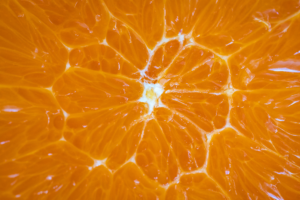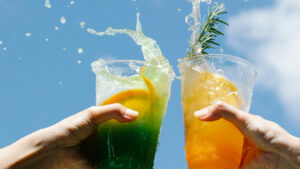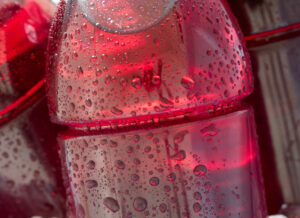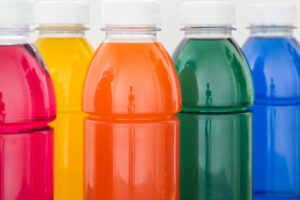With so many natural colors available, choosing the perfect one for your beverage application can feel overwhelming. Whether you’re developing an RTD, dry-mix, or alcoholic beverage, there are some important factors to consider when selecting your natural color. We’ve broken down the top 5 considerations when coloring beverages to make your color selection process as smooth as possible.
1. Ingredient Interactions
Today’s consumers seek functional beverages that may contain additional ingredients like flavors, botanicals, vitamins, and minerals. These ingredients have the potential to interact with natural colors, causing some to precipitate or destabilize. For example, colors like beta-carotene contain emulsifiers which keep them miscible in the water phase of beverages. Natural clouds may also contain emulsification systems. If the emulsifiers are not compatible, the color or cloud emulsion may destabilize. A broken emulsion is often characterized by a ring of color appearing at the top of the beverage.
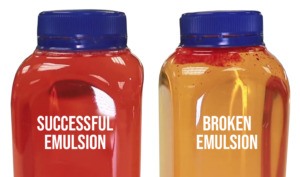
Another area of consideration is the addition of ascorbic acid to some beverages, like enhanced waters. If anthocyanins are used to color these kinds of beverages, the ascorbic acid will cause fading of the color over time. On the other hand, the addition of ascorbic acid to a beverage containing a carotenoid, like beta-carotene, will actually improve the color stability.
2. Regulatory
Knowing the countries or regions of final beverage sale during the product development stage helps streamline the regulatory review of proposed colors for use in beverages. Countries may have different legal requirements or limitations for which colors may be used. For example, safflower is permitted in the EU for beverages, but not in the US. Sodium copper chlorophyllin is permitted in the US for dry mix citrus beverages, but not for ready-to-drink (RTD) beverages. Apocarotenal is permitted in beverages, but it cannot exceed 15 milligrams per pint of liquid.
Along with knowing the regulatory requirements, it is also important to know how each color will affect the finished product label. Although carmine may provide a nice red hue for a berry flavored beverage, it does not qualify for vegan or kosher status. In this case, you could blend anthocyanins to obtain a red color from fruit and vegetable juices to allow for these claims.
3. Processing Time & Temperature
Processing time and temperature vary widely depending on the type of beverage and can also have an impact on which natural colors you choose. Plant or dairy-based beverages that are shelf stable require UHT pasteurization. These high processing temperatures will cause fading for some natural colors. Colors like emSeal® beta-carotene and turmeric, paprika, annatto, and caramel color are more heat stable. Although red beet color may deliver an enticing raspberry colored beverage, red beet will not withstand the UHT process. Natural colors are mostly robust to HTST processing for drinks like enhanced waters, isotonics, and energy drinks, but benefit from rapid cooling after heat processing.
4. Base Color & pH
As the demand for plant-based beverages increases, new challenges develop for using natural colors. Many plant-based milks, like oat and almond, are a beige to off-white color. Adding natural colors to a beige background can shift the hue of the natural color to an unintended appearance.

Sometimes a tinted base color works well with the natural color you’re using. For example, if you were creating a caramel macchiato flavored oat milk, adding a class I caramel color will complement the brownness of oat milk enhancing the perception of the desired flavor. Clear, colorless beverages allow beverage designers the flexibility to incorporate natural colors without interference from the original base color. However, the addition of certain vitamins may tint a clear base. For example, riboflavin could tint the base yellow making it difficult to overcome when designing a mixed berry RTD colored with anthocyanins like purple carrot or Amaize® Red, a non-GM purple corn color.
Also, be sure to consider the beverage’s pH when selecting a natural color. The higher pH of plant-based milks favors the use of colors like turmeric, annatto, and emSeal® beta-carotene and paprika whose appearance does not depend on pH. Colors like anthocyanins from fruit and vegetable juices may look like an interesting purple/blue color at higher pH, but they will fade due to poor stability at pH above 4.5.
5. Packaging, Storage, & Shelf Life
It’s important to consider packaging, storage conditions, and shelf life when choosing a natural color for your beverage. To improve the shelf life, consider using opaque packaging that may protect the product from light to minimize color changes or fading. Some natural colors, such as turmeric and spirulina will fade when exposed to light for an extended period of time, so opaque packaging is the best choice to prevent fading. The light stability of beta-carotene can be enhanced by adding ascorbic acid. To prolong the stability of your beverage it’s best to store the finished product in a cool warehouse.
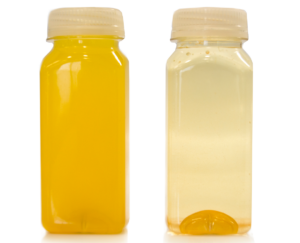
Choosing the right natural color for your beverage application has its obstacles, but finding the perfect one is so refreshing! Need some help deciding? Contact us with your questions or Request a Sample to get started on your next project.



